AUX FORD F-650/750 2018 Owners Manual
[x] Cancel search | Manufacturer: FORD, Model Year: 2018, Model line: F-650/750, Model: FORD F-650/750 2018Pages: 386, PDF Size: 9.01 MB
Page 1 of 386
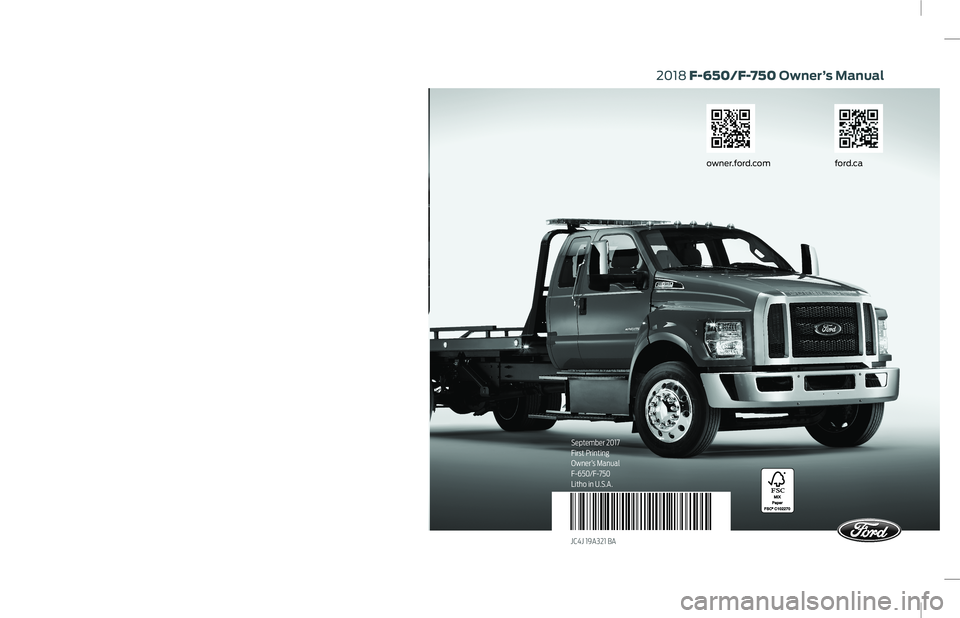
2018 F-650/F-750 Owner’s Manual
September 2017
First Printing
Owner’s Manual
F-650/F-750
Litho in U.S.A.
JC4J 19A321 BA
owner.for d.com ford.caSeptembre 2017
Première impression
Manuel du propriétaire
F-650/F-750
Imprimé aux États-Unis
JC4J 19A321 BA
Manuel du propriétaire F-650/F-750 2018
Page 5 of 386
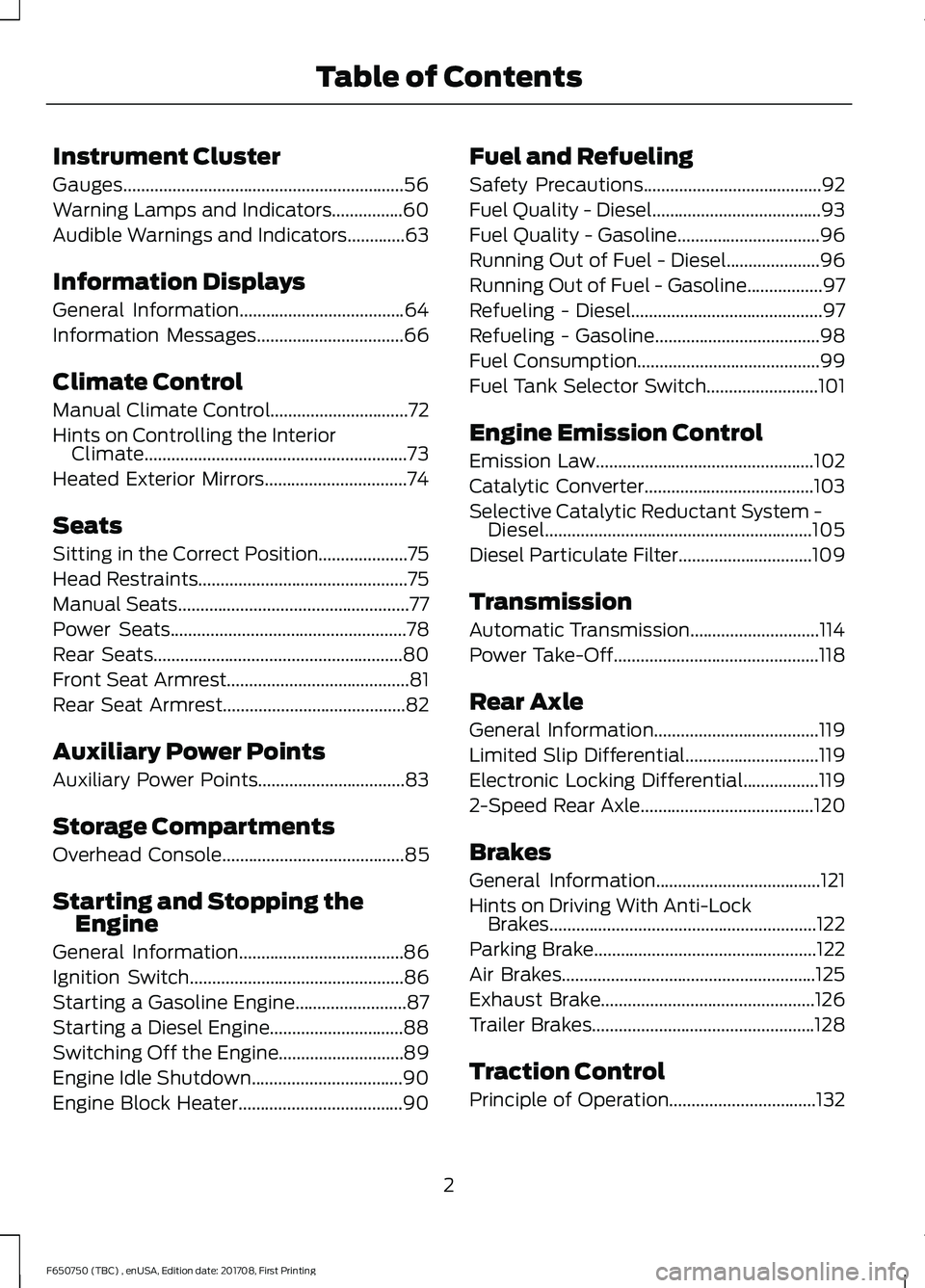
Instrument Cluster
Gauges...............................................................56
Warning Lamps and Indicators
................60
Audible Warnings and Indicators.............63
Information Displays
General Information
.....................................64
Information Messages
.................................66
Climate Control
Manual Climate Control
...............................72
Hints on Controlling the Interior Climate...........................................................73
Heated Exterior Mirrors................................74
Seats
Sitting in the Correct Position....................75
Head Restraints...............................................75
Manual Seats....................................................77
Power Seats
.....................................................78
Rear Seats........................................................80
Front Seat Armrest.........................................81
Rear Seat Armrest
.........................................82
Auxiliary Power Points
Auxiliary Power Points.................................83
Storage Compartments
Overhead Console
.........................................85
Starting and Stopping the Engine
General Information.....................................86
Ignition Switch
................................................86
Starting a Gasoline Engine
.........................87
Starting a Diesel Engine..............................88
Switching Off the Engine............................89
Engine Idle Shutdown..................................90
Engine Block Heater
.....................................90 Fuel and Refueling
Safety Precautions........................................92
Fuel Quality - Diesel......................................93
Fuel Quality - Gasoline................................96
Running Out of Fuel - Diesel
.....................96
Running Out of Fuel - Gasoline.................97
Refueling - Diesel...........................................97
Refueling - Gasoline.....................................98
Fuel Consumption
.........................................99
Fuel Tank Selector Switch.........................101
Engine Emission Control
Emission Law
.................................................102
Catalytic Converter
......................................103
Selective Catalytic Reductant System - Diesel............................................................105
Diesel Particulate Filter..............................109
Transmission
Automatic Transmission.............................114
Power Take-Off..............................................118
Rear Axle
General Information
.....................................119
Limited Slip Differential..............................119
Electronic Locking Differential
.................119
2-Speed Rear Axle
.......................................120
Brakes
General Information
.....................................121
Hints on Driving With Anti-Lock Brakes............................................................122
Parking Brake
..................................................122
Air Brakes.........................................................125
Exhaust Brake................................................126
Trailer Brakes..................................................128
Traction Control
Principle of Operation.................................132
2
F650750 (TBC) , enUSA, Edition date: 201708, First Printing Table of Contents
Page 8 of 386

Accessories
Auxiliary Switches........................................316
Ford Protect
Ford Protect....................................................318
Scheduled Maintenance
General Maintenance Information.......320
Normal Scheduled Maintenance
...........325
Special Operating Conditions Scheduled Maintenance.............................................330
Scheduled Maintenance Record
...........340
Appendices
Electromagnetic Compatibility
..............350
End User License Agreement..................352
5
F650750 (TBC) , enUSA, Edition date: 201708, First Printing Table of Contents
Page 13 of 386
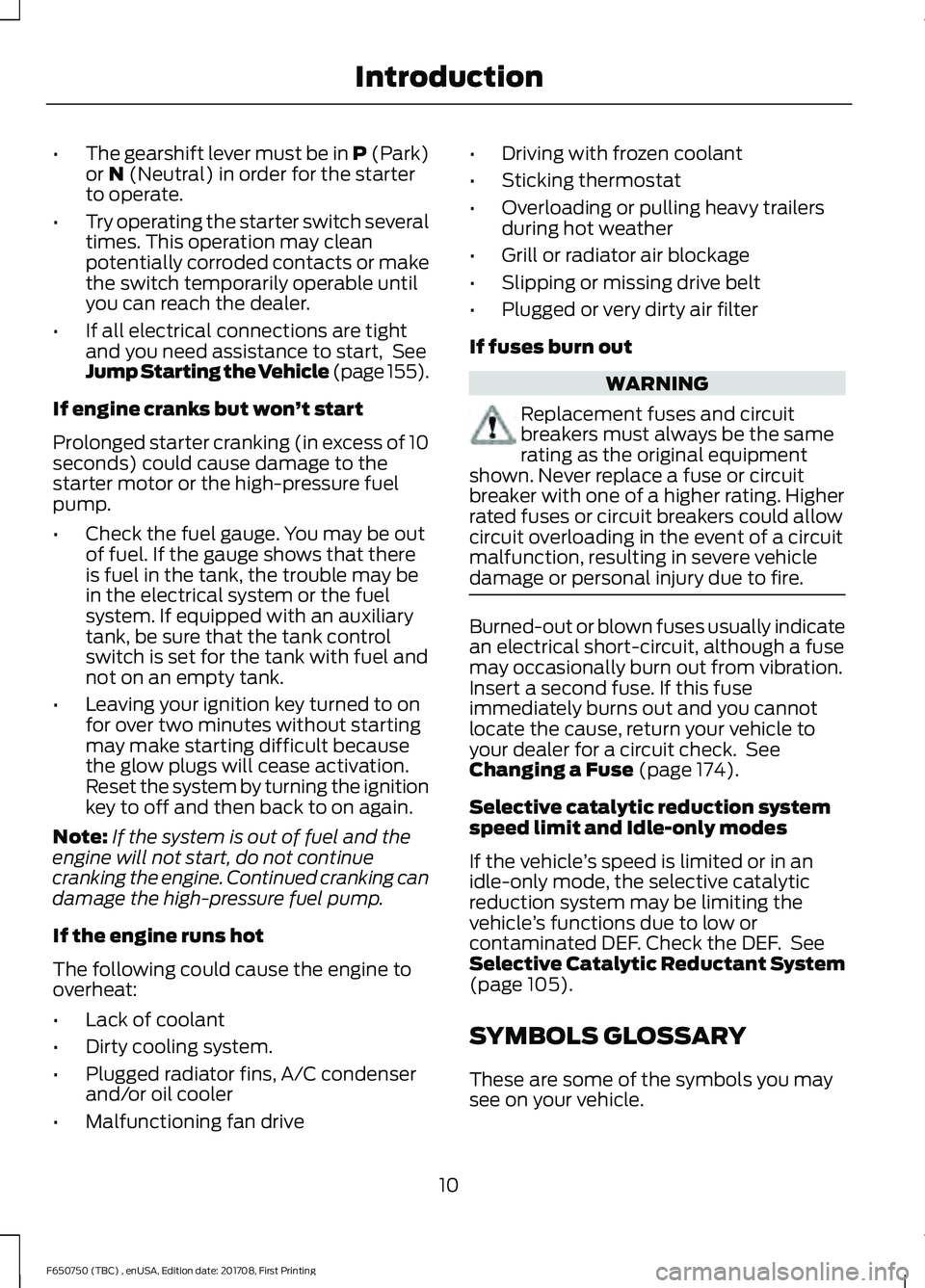
•
The gearshift lever must be in P (Park)
or N (Neutral) in order for the starter
to operate.
• Try operating the starter switch several
times. This operation may clean
potentially corroded contacts or make
the switch temporarily operable until
you can reach the dealer.
• If all electrical connections are tight
and you need assistance to start, See
Jump Starting the Vehicle (page 155).
If engine cranks but won ’t start
Prolonged starter cranking (in excess of 10
seconds) could cause damage to the
starter motor or the high-pressure fuel
pump.
• Check the fuel gauge. You may be out
of fuel. If the gauge shows that there
is fuel in the tank, the trouble may be
in the electrical system or the fuel
system. If equipped with an auxiliary
tank, be sure that the tank control
switch is set for the tank with fuel and
not on an empty tank.
• Leaving your ignition key turned to on
for over two minutes without starting
may make starting difficult because
the glow plugs will cease activation.
Reset the system by turning the ignition
key to off and then back to on again.
Note: If the system is out of fuel and the
engine will not start, do not continue
cranking the engine. Continued cranking can
damage the high-pressure fuel pump.
If the engine runs hot
The following could cause the engine to
overheat:
• Lack of coolant
• Dirty cooling system.
• Plugged radiator fins, A/C condenser
and/or oil cooler
• Malfunctioning fan drive •
Driving with frozen coolant
• Sticking thermostat
• Overloading or pulling heavy trailers
during hot weather
• Grill or radiator air blockage
• Slipping or missing drive belt
• Plugged or very dirty air filter
If fuses burn out WARNING
Replacement fuses and circuit
breakers must always be the same
rating as the original equipment
shown. Never replace a fuse or circuit
breaker with one of a higher rating. Higher
rated fuses or circuit breakers could allow
circuit overloading in the event of a circuit
malfunction, resulting in severe vehicle
damage or personal injury due to fire. Burned-out or blown fuses usually indicate
an electrical short-circuit, although a fuse
may occasionally burn out from vibration.
Insert a second fuse. If this fuse
immediately burns out and you cannot
locate the cause, return your vehicle to
your dealer for a circuit check. See
Changing a Fuse
(page 174).
Selective catalytic reduction system
speed limit and Idle-only modes
If the vehicle ’s speed is limited or in an
idle-only mode, the selective catalytic
reduction system may be limiting the
vehicle ’s functions due to low or
contaminated DEF. Check the DEF. See
Selective Catalytic Reductant System
(page
105).
SYMBOLS GLOSSARY
These are some of the symbols you may
see on your vehicle.
10
F650750 (TBC) , enUSA, Edition date: 201708, First Printing Introduction
Page 20 of 386
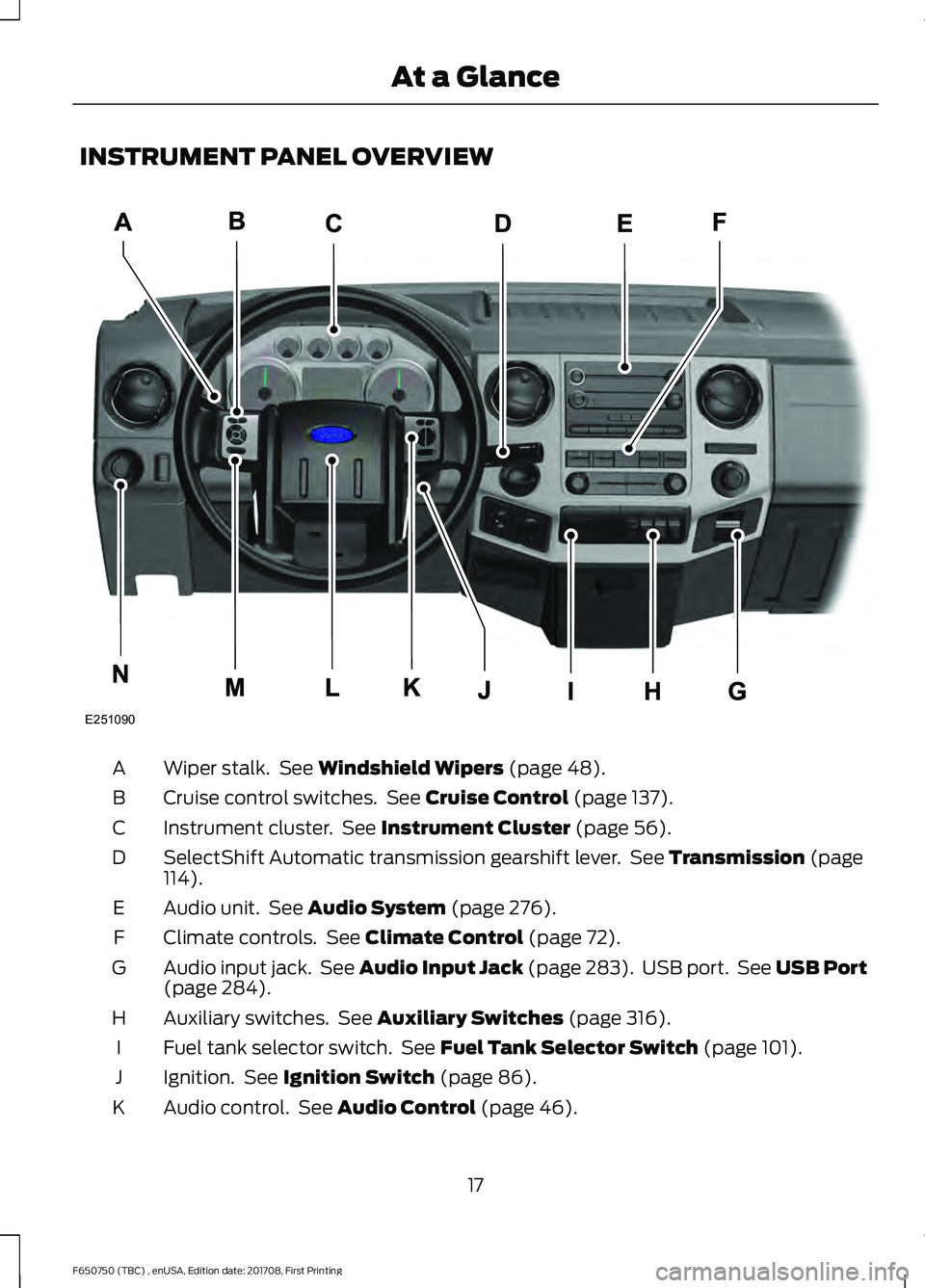
INSTRUMENT PANEL OVERVIEW
Wiper stalk. See Windshield Wipers (page 48).
A
Cruise control switches. See
Cruise Control (page 137).
B
Instrument cluster. See
Instrument Cluster (page 56).
C
SelectShift Automatic transmission gearshift lever. See
Transmission (page
114).
D
Audio unit. See
Audio System (page 276).
E
Climate controls. See
Climate Control (page 72).
F
Audio input jack. See Audio Input Jack (page 283). USB port. See USB Port
(page
284).
G
Auxiliary switches. See
Auxiliary Switches (page 316).
H
Fuel tank selector switch. See
Fuel Tank Selector Switch (page 101).
I
Ignition. See
Ignition Switch (page 86).
J
Audio control. See
Audio Control (page 46).
K
17
F650750 (TBC) , enUSA, Edition date: 201708, First Printing At a GlanceE251090
Page 56 of 386
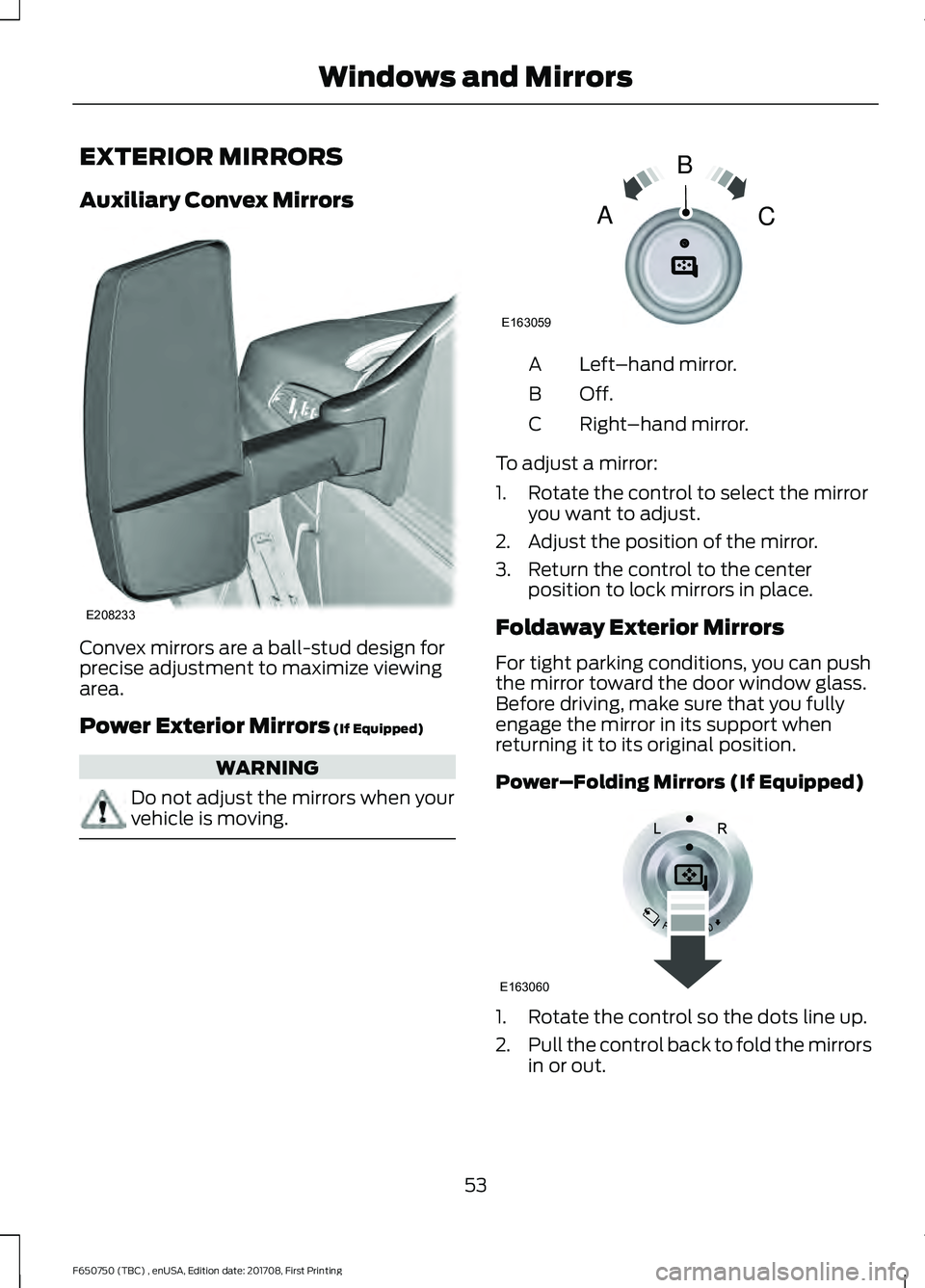
EXTERIOR MIRRORS
Auxiliary Convex Mirrors
Convex mirrors are a ball-stud design for
precise adjustment to maximize viewing
area.
Power Exterior Mirrors (If Equipped)
WARNING
Do not adjust the mirrors when your
vehicle is moving. Left
–hand mirror.
A
Off.B
Right–hand mirror.
C
To adjust a mirror:
1. Rotate the control to select the mirror you want to adjust.
2. Adjust the position of the mirror.
3. Return the control to the center position to lock mirrors in place.
Foldaway Exterior Mirrors
For tight parking conditions, you can push
the mirror toward the door window glass.
Before driving, make sure that you fully
engage the mirror in its support when
returning it to its original position.
Power–Folding Mirrors (If Equipped) 1. Rotate the control so the dots line up.
2.
Pull the control back to fold the mirrors
in or out.
53
F650750 (TBC) , enUSA, Edition date: 201708, First Printing Windows and MirrorsE208233 E163059
B
AC E163060
Page 84 of 386

FRONT SEAT ARMREST
Press the button on the right-hand side of
the seat and pull the seatback down to
release the armrest. You can also gain
access to the cupholders and seatback
storage bin.
Pull up on the tab to open the storage bin
Lift up on the seatback to return it to the
upright position. If your vehicle has an under-seat storage
compartment in the seat cushion, lift the
latch to open the lid of the compartment.
You cannot open the lid when the armrest
is down.
The under-seat storage compartment has
a programmable lock. Use the ignition key
to program the lock to the compartment.
You can power or charge electronics using
the under-seat storage compartment
auxiliary power point. See Auxiliary
Power Points (page 83).
81
F650750 (TBC) , enUSA, Edition date: 201708, First Printing SeatsE162745 E162746 E162747 E162748
Page 86 of 386
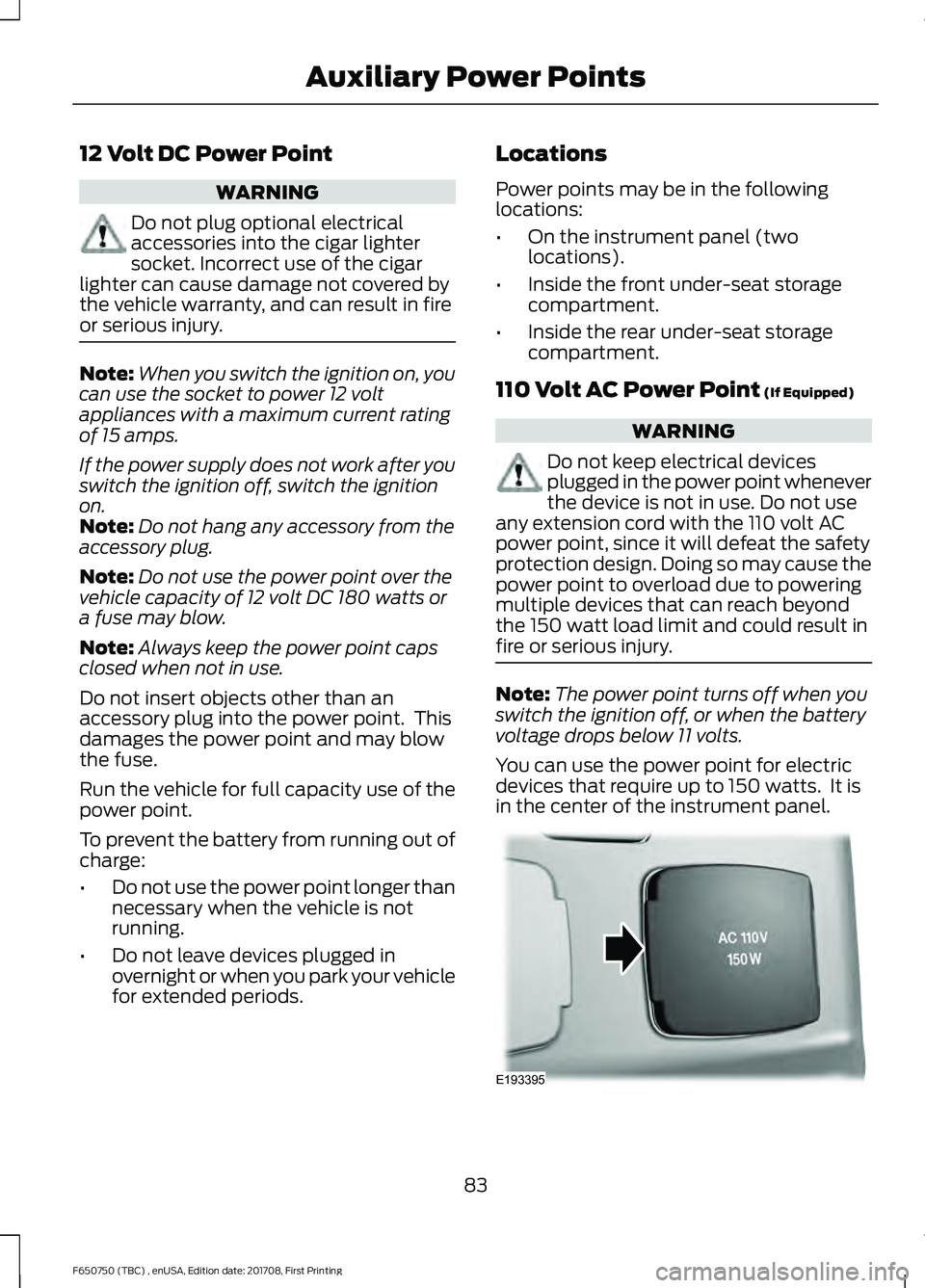
12 Volt DC Power Point
WARNING
Do not plug optional electrical
accessories into the cigar lighter
socket. Incorrect use of the cigar
lighter can cause damage not covered by
the vehicle warranty, and can result in fire
or serious injury. Note:
When you switch the ignition on, you
can use the socket to power 12 volt
appliances with a maximum current rating
of 15 amps.
If the power supply does not work after you
switch the ignition off, switch the ignition
on.
Note: Do not hang any accessory from the
accessory plug.
Note: Do not use the power point over the
vehicle capacity of 12 volt DC 180 watts or
a fuse may blow.
Note: Always keep the power point caps
closed when not in use.
Do not insert objects other than an
accessory plug into the power point. This
damages the power point and may blow
the fuse.
Run the vehicle for full capacity use of the
power point.
To prevent the battery from running out of
charge:
• Do not use the power point longer than
necessary when the vehicle is not
running.
• Do not leave devices plugged in
overnight or when you park your vehicle
for extended periods. Locations
Power points may be in the following
locations:
•
On the instrument panel (two
locations).
• Inside the front under-seat storage
compartment.
• Inside the rear under-seat storage
compartment.
110 Volt AC Power Point (If Equipped) WARNING
Do not keep electrical devices
plugged in the power point whenever
the device is not in use. Do not use
any extension cord with the 110 volt AC
power point, since it will defeat the safety
protection design. Doing so may cause the
power point to overload due to powering
multiple devices that can reach beyond
the 150 watt load limit and could result in
fire or serious injury. Note:
The power point turns off when you
switch the ignition off, or when the battery
voltage drops below 11 volts.
You can use the power point for electric
devices that require up to 150 watts. It is
in the center of the instrument panel. 83
F650750 (TBC) , enUSA, Edition date: 201708, First Printing Auxiliary Power PointsE193395
Page 87 of 386
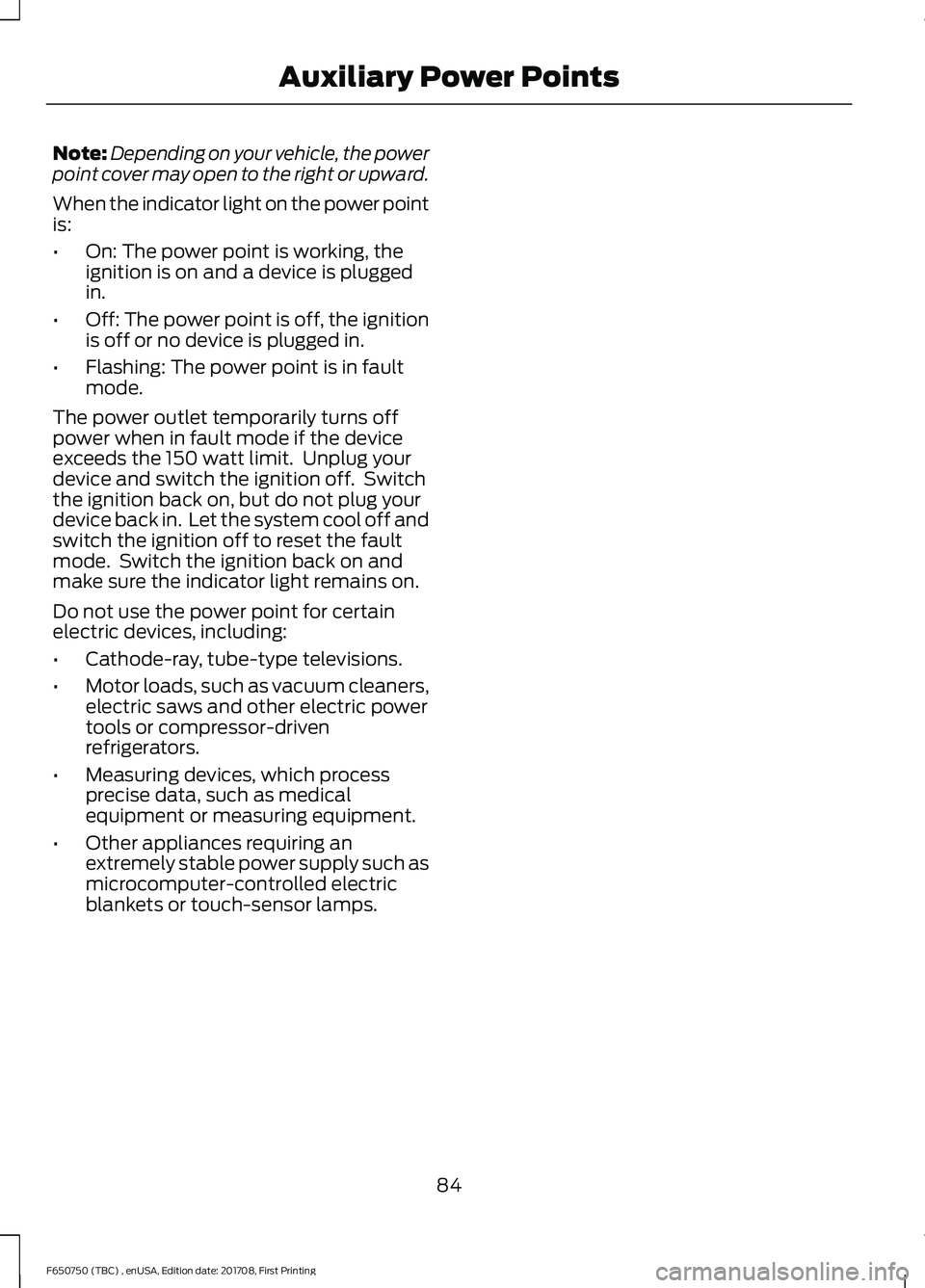
Note:
Depending on your vehicle, the power
point cover may open to the right or upward.
When the indicator light on the power point
is:
• On: The power point is working, the
ignition is on and a device is plugged
in.
• Off: The power point is off, the ignition
is off or no device is plugged in.
• Flashing: The power point is in fault
mode.
The power outlet temporarily turns off
power when in fault mode if the device
exceeds the 150 watt limit. Unplug your
device and switch the ignition off. Switch
the ignition back on, but do not plug your
device back in. Let the system cool off and
switch the ignition off to reset the fault
mode. Switch the ignition back on and
make sure the indicator light remains on.
Do not use the power point for certain
electric devices, including:
• Cathode-ray, tube-type televisions.
• Motor loads, such as vacuum cleaners,
electric saws and other electric power
tools or compressor-driven
refrigerators.
• Measuring devices, which process
precise data, such as medical
equipment or measuring equipment.
• Other appliances requiring an
extremely stable power supply such as
microcomputer-controlled electric
blankets or touch-sensor lamps.
84
F650750 (TBC) , enUSA, Edition date: 201708, First Printing Auxiliary Power Points
Page 121 of 386

9. Start your vehicle.
Perform Steps 4 through 8 in reverse order,
making sure to engage the hinge pivots
between the upper and lower halves of the
shroud. Keep slight pressure in the forward
direction as you rotate the halves together.
If Your Vehicle Gets Stuck In Mud
or Snow
Note:
Do not rock your vehicle if the engine
is not at normal operating temperature or
damage to the transmission may occur.
Note: Do not rock your vehicle for more
than a minute or damage to the
transmission and tires may occur, or the
engine may overheat.
If your vehicle is stuck in mud or snow, you
may rock it out by shifting between forward
and reverse gears, stopping between shifts
in a steady pattern. Press lightly on the
accelerator in each gear.
POWER TAKE-OFF
Auxiliary equipment called power take-off,
or PTO, is often added to the engine or
transmission to operate utility equipment.
Examples include a wheel-lift for tow
trucks, cranes, tools for construction or tire
service and pumping fluids. PTO
applications draw auxiliary horsepower
from the powertrain, often while the vehicle is stationary or mobile. In the
stationary condition, there is limited
cooling air flow through the radiator and
around the vehicle that normally occurs
when a vehicle is moving. The aftermarket
PTO system installer, having the most
knowledge of the final application, is
responsible for determining whether
additional chassis heat protection or
powertrain cooling is required and alerting
the user to the safe and proper operation.
Your vehicle is approved for use as a
Stationary Mode, SplitShaft Mode or
Mobile Mode power source within the limits
and operating guidelines detailed in the
Ford Truck Body Builders Layout Book,
found at
www.fleet.ford.com/truckbbas.com and
through the Ford Truck Body Builders
Advisory Service. The transmission power
source modes are engine specific.
118
F650750 (TBC) , enUSA, Edition date: 201708, First Printing TransmissionE163186